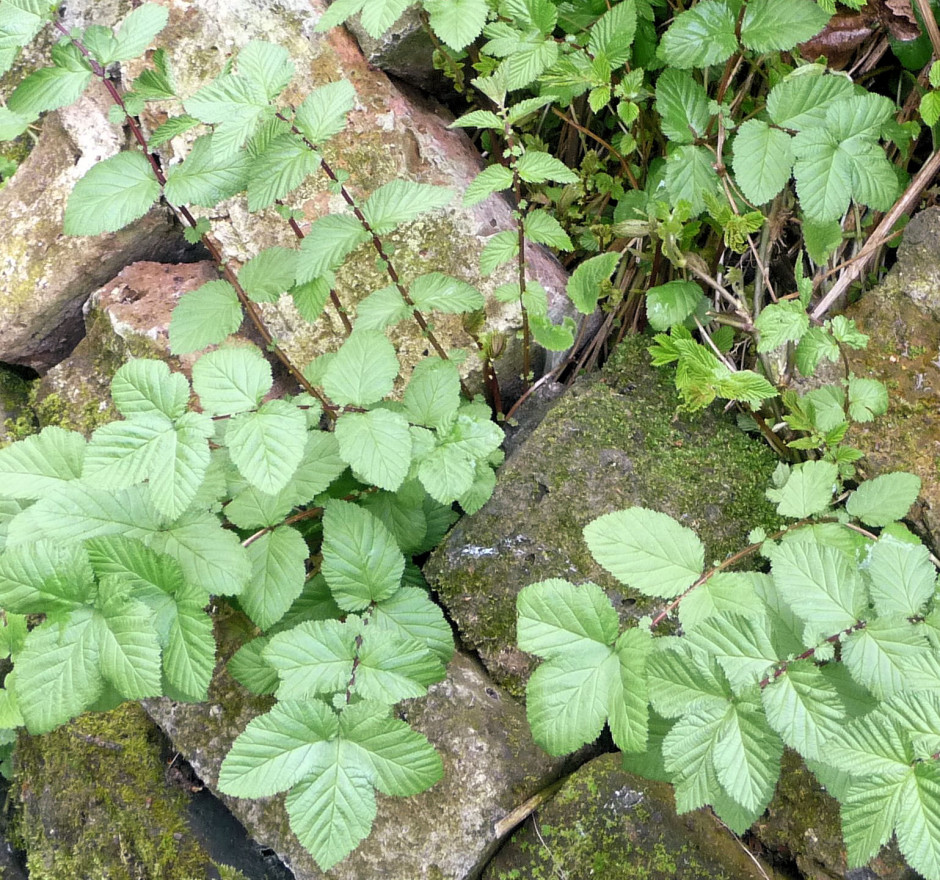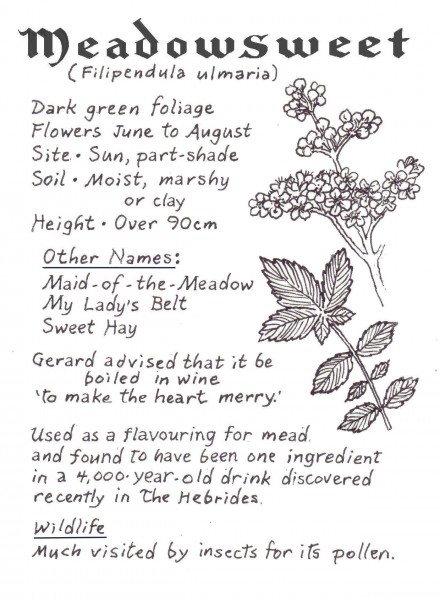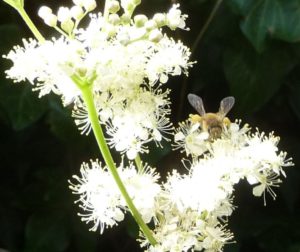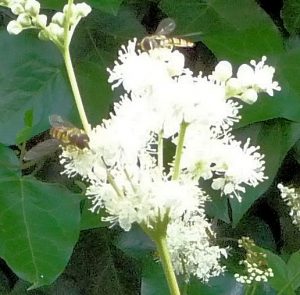MEADOWSWEET (Filipendula ulmaria)
Europe, W Asia
Meadowsweet is a perennial herb in the Rose family that can be found throughout the country. It prefers sunshine, growing on damp ground, in wet meadows, ditches, swamps, marshes & along riverbanks.
The pleated leaves of Filipendula ulmaria are dark green on the upper side & downy underneath, with a heavy almond-like aroma. The plant’s strong reddish-brown stems can grow to 4 ft in height.
From June a froth of tiny CREAM flowers with the fragrance of vanilla appears at the stem tips. They are in bloom through August.
‘Like plumes of candy floss on sticks…’
James Wong, GROW YOUR OWN DRUGS, Collins 2009
Bees’ Favourite.
The sweet scent of these flowers animates the many bees drawn to Meadowsweet for its pollen, as can be seen on our videos. Moths, dragonflies, hoverflies, ladybirds & other pollinators are also keen on this wildflower.
“Meadowsweet is the food plant for the larvae of several moth species including the emperor moth, grey pug, Hebrew character, lime-speck pug, mottled beauty, and the satellite.”
https://www.woodlandtrust.org.uk › trees-woods-and-wildlife › plants › wild-flowers
RHS Perfect for Pollinators
 Meadowsweet is on the list of plants rated by the RHS Perfect for Pollinators. These insects transfer pollen and increase seed set and fruit development.
Meadowsweet is on the list of plants rated by the RHS Perfect for Pollinators. These insects transfer pollen and increase seed set and fruit development.
Find out more at: rhs.org.uk/plants
Strewing, Dyeing & Scouring
“…the scent of the leaves is quite different from that of the flowers. The latter possess an almondlike fragrance, it is one of the fragrant herbs used to strew the floors of chambers. In allusion to this, Gerard writes:
‘The leaves and floures of Meadowsweet farre excelle all other strowing herbs for to decke up houses, to strawe in chambers, halls and banqueting-houses in the summer-time, for the smell thereof makes the heart merrie and joyful and delighteth the senses.’ “
Maud Grieve, A Modern Herbal 1931, Botanical.com
The Celts used the roots of Meadowsweet to produce a black dye; a blue pigment was obtained from the leaves, & yellow from the top of the plant.
In Ireland Meadowsweet is used to scour milk vessels. http://irishhedgerows.weebly.com/flora.html
Medicinal
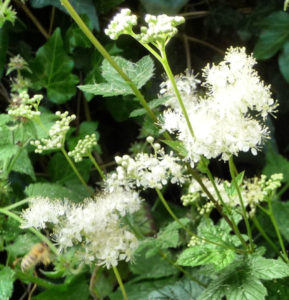 …flowery tops contain Salicylic acid – nature’s aspirin’. In 1897, chemists at Bayer produced synthetically altered salicin, which helps alleviate fever, headache and pain. They named it Aspirin (acetyl + spiraea ulmaria) after the plant’s earlier botanical name, Spiraea ulmaria.
…flowery tops contain Salicylic acid – nature’s aspirin’. In 1897, chemists at Bayer produced synthetically altered salicin, which helps alleviate fever, headache and pain. They named it Aspirin (acetyl + spiraea ulmaria) after the plant’s earlier botanical name, Spiraea ulmaria.
http://www.indianmirror.com/ayurveda/ayurveda.html
Anti-inflsmmatory – ‘ Containing salicylic acid, Meadowsweet is an effective herb against inflammation. It is now thought that most diseases can be traced back to chronic low-level inflammation, making this herb an extremely useful tool in your natural health kit. Salicylic acid is more famously known to come from Willow, however the other compounds within Meadowsweet make it much easier on the lining of the stomach.’
https://www.indigo-herbs.co.uk/natural-health-guide/benefits/meadowsweet
Herbal and Traditional
‘The name meadowsweet is said to come, not from the fact that it grows in meadows as one would expect, but from its early use to flavour mead, evolving from Middle English Medewurte, as it appears in Chaucer’s The Knight’s Tale.
In Irish mythology, Cú Chulainn, the warlike hero of the Ulster Cycle, is said to have used meadowsweet baths to calm his rages and fevers…
The smell is very distinctive and I have heard it compared to everything from deep heat to marzipan to pickled cucumber! To me it smells sweetly fragrant with an edge of the disinfectant TCP that I remember from childhood.’
Lucinda Warner, Whispering Earth
“One of thirty herbs and spices added to the popular Norfolk punch cordial drink, originally made by the monks of Norfolk, England. All parts of the plant can be added to soups, sauces or stewed fruit for an aromatic flavour. The bitter roots have been used as a tea substitute along with the leaves and flowers.”
Sacred to the Druids, Meadowsweet was laid on floors in the Middle Ages as a fragrant strewing herb to be walked on, or on wooden church pews to be sat on. For medieval wedding festivals it was strewn with Salad Burnet, which smells of cucumber.
Jacqueline Hodson, The Smell of the Middle Ages, http://www.triviumpublishing.com/articles/smellofthemiddleages.html
Scents of the Middle Ages, http://www.gallowglass.org/jadwiga/herbs/scents.html
“a celebrated herb in Celtic times, representing the Flowerbride, otherwise known as “Blodeuwedd” – the maiden aspect of the triple goddess. This gentle flower was used to attract love, peace and happiness and was especially popular in love spells and potions. Adding this flower to a bridal bouquet was thought to bring joy and blessings to the bride! Also enjoying a long history as a strewing herb, Meadowsweet’s flowery, astringent properties made it an excellent choice for dwellings, serving as an insect repellent as well as a disinfectant.”
https://www.indigo-herbs.co.uk/natural-health-guide/benefits/meadowsweet
Other names: Altarreina, Barbe de Bouc, Barbe de Chevre, Brideswort, Courtship and Marriage, Crios Chu-chulainn, Dolloff, Dropwort, Ergecsakali, Fausse Spiree, Filipendule, Floron, Goat’s Beard, Hayriff, Hierba de las abejas, Honey-flower, Honey-sweet, Kiss Me Quick, Lady of the Meadow, Maid of the Meadow, Meadow-Wort, Meadswort, Meadsweet, Moerasspirea, Mountain Spirea, Petite Reine, Pride of the Meadow, Quaker Lady, Queen of the Ditch, Queen of the Meadow, Queen of the Prairie, Racine de Gravier, Reina de los Prados, Reine de la Prairie, Reine-des-Pres, Spiraeae Flos, Spireae Herba, Ulmaria.
Our Meadowsweet patch began life as a rooted stem, given away by the conservation team at Gillespie Park’s Ecology Centre. Dug up one Volunteer Day as we replanted the entrance on Gillespie Road, it made way for other plants.
Brought back to our garden & planted in sun at the damp edge of the fern bed, it blooms every summer with nearby Purple Loosestrife, bringing in the bees. No pests or diseases trouble it.
VIDEO – SUMMERBREEZE, MEADOWSWEET
VIDEO – BEES ON MEADOWSWEET

